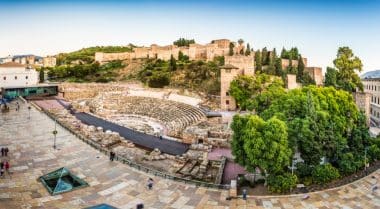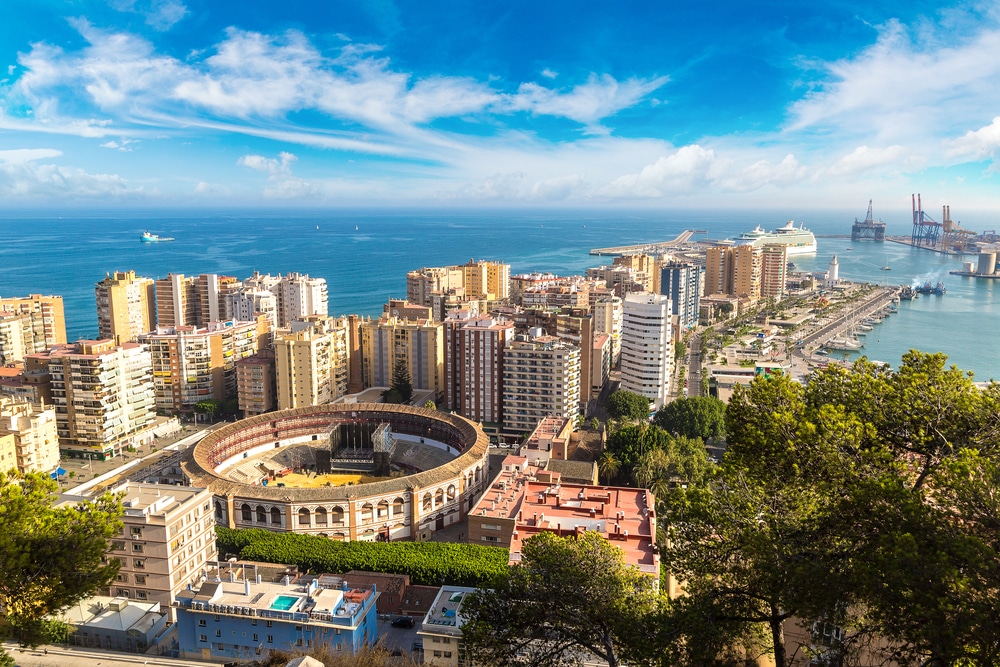Málaga – Exotic buildings, fiery temperament, proud people and Moorish splendour, plus a seemingly never-ending summer – Andalusia’s largest coastal metropolis enchants with snow or sand, hustle and bustle or solitude, with opulent luxury or with the simple life of the south. In addition, the new harbour area, exciting museums, a lively old town, enchanted parks and, last but not least, the notorious Costa del Sol – Málaga is really fun.
In Málaga, many people have lost their hearts
As a tourist destination, Malaga is so diverse that everyone can find what they are looking for. No region in Spain is so contrasting.
The bays east of Nerja on the Costa del Sol are picture-perfect. Spain’s sunny coast offers plenty of space for sun worshippers and sandpipers – it attracts with long, white beaches. While people are still swimming on the coast, snowflakes are falling from the sky 50 kilometers away and skiers are weaving down the slopes of the Sierra Nevada .
Good to know:
Early on Sunday morning, Málaga is an oasis of peace: the city is still in deep sleep, the alleys are empty, no noisy visitors, no blatant vendors – the lively city center shows its charm in the silence for a moment – wonderful. It is worth leaving very early on a Sunday morning.
Málaga is magical, idyllic, nostalgic and beautiful. That wasn’t always the case. At that time, a uniform concrete desert poured over the coastal lowlands. In some cases, there are insane excesses of an unbridled building frenzy. The area between Fuengirola and the greater Málaga area has been hit particularly badly. Once discredited as the dirty child of the Costa del Sol , Málaga is regaining its old splendour and captivating with a sparkling clean old town, exciting museums and culinary delights to melt away.
Desire for sightseeing – a small travel guide for city strollers
The centre of Málaga is extremely interesting in terms of urban planning and comforts over the building sins. This is where people have built, hammered and restored – one gem follows the other. During a stroll through the city, you can enjoy the Mediterranean lifestyle. Countless cozy tapas pubs and trendy cafés line the narrow streets. Nostalgia is a constant companion. Every now and then, the chair on which you enjoy your coffee creaks – here and there some paint peels off the façade. Meanwhile, the chic fashion boutiques on Calle Marqués de Larios tempt you to make lavish purchases.
This is also unique to Málaga: every evening a very special flower is sold in the old town. Over the summer, it fills the streets with its wonderful scent.
Must-sees in Malaga:
- The cathedral with its sumptuously carved choir stalls from the 17th century forms a striking point in the old town. With its towering tower, it can be seen from afar.
- The Museo Carmen Thyssen is also located in the old town. It presents itself as a cultural highlight costing 25 million euros with over 200 works from the top-class, famous collection of Baroness Thyssen-Bornemisza.
- Plaza de Toros – Málaga’s bullring has been the oldest in Spain since 1785. Since 1876, it has been considered a cultural asset of the state. On two floors, the completely covered rows of seats are surrounded by an unusually large round.
- Tabacalera is the Museo Automovilistico y de la Moda and is home to many shapely vehicles from all decades.
Between Picasso and Alcazaba
The “Museo Picasso de Málaga” is dedicated to the great artist Picasso and the city’s most famous son.

The city has erected a worthy monument to the brilliant painter, who was born in Málaga in October 1881.
The museum is located in the middle of the old town, not far from the birthplace. The Palacio de Buenvista, a magnificent building from the 16th century, was chosen as the exhibition building. Since 2003, it has housed loans from the Picasso family. The number of works of art to be donated was so large that adjacent new buildings were erected in order to be able to exhibit the numerous paintings, sculptures and ceramics.
At the foot of the castle hill lies the Moorish palace Alcazaba, an impressive testimony to Arab architecture. The palace is said to have once been as beautiful as the Alhambra of Granada . Romantic corners with great views and quiet gardens with water features remind us of the old splendour.
Admittedly, the path within the Alcazaba is a little arduous. This is not unusual, because after all, you are moving in a fortress. Bravely, with a few beads of sweat on their foreheads, visitors walk along the defensive towers to the former palace rooms. The ascent offers breathtaking views over the coast of Málaga and the Mediterranean Sea. The interior of the fortress captivates with an incredible variety of flowers and plants.
There is also a more comfortable way – but less romantic: modern people no longer struggle, but get into an elevator, which is located in the mountain. Immediately you end up in the old palace.
On a hill above the city sits another fortress of Málaga. It is connected to the Alcazaba by a walled passageway. A visit to the Castillo de Gibralfaro is worthwhile for the magical view over the whole of Málaga.
Andalusian temperament
The Malangueños love their rituals: in addition to the tapas tours in the evening or strolling along the Calle Marqués de Larios, the procession of gypsies attracts with flamenco rhythms. The Easter procession attracts thousands of onlookers. Every year, a prisoner is released from the local prison, who then travels through the city – unrecognizable under a hood – together with the soldiers of the Legion.
What Málaga tastes like
Absolutely unique in Spain: El Tintero – here the guest has to be quick when the waiters dash through the rows and loudly advertise the food. It is important to raise your hand before another guest does. The waiters make themselves heard loudly – an unusual, but rustic spectacle.
In addition, a visit to the popular beach bars is worthwhile. In Málaga, they are cult. In summer, fish is grilled on open fires. The beach stalls of Pedregalejo and Malagueta are recommended.
The scent of orange blossom in the realm of the sugar barons
Everywhere in the streets grow fat ornamental oranges all around. This fact is emphasized by Jardin de Azahar, the garden of the orange blossom with the most extraordinary guest house in Malaga. From here it is only a few steps to Pedregalejo, a very special peripheral district on the waterfront with a magnificent beach.
Once upon a time, many Gitanos lived here next to dilapidated villas in simple beach houses, for which a permit was usually missing. In the meantime, the district has blossomed. In a beautiful beach location, the sea very close, the district is now a sought-after address. There are lovely cafes and bars with great views of the city skyline, the harbour and the incoming ships. The waterfront is lined with palm trees. Not far away is the Balneario in a huge overgrown park.
This pool was closed for a long time. Today it shines in new splendor, attracts with a nostalgic beach bar and bears witness to the former splendor of Málaga, which is returning more and more. The beautiful location alone is worth a visit: green Montes de Málaga grow upwards, mountains frame the city on the land side and the glittering expanse of the Mediterranean Sea appears opposite.
It is fragrant, the air is gentle, soft and humid, the climate is mild – Málaga is a place to return to.
Können wir Ihnen helfen?
Benötigen Sie Unterstützung bei Ihrer Reiseplanung oder weitergehende Informationen zu einzelnen Reisezielen? Wir freuen uns über Ihre Kontaktaufnahme.


